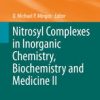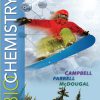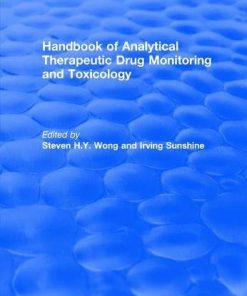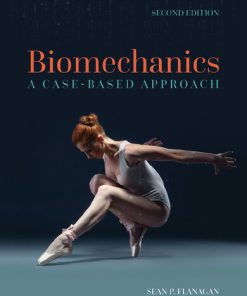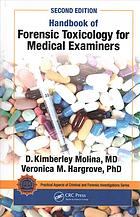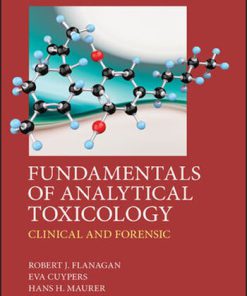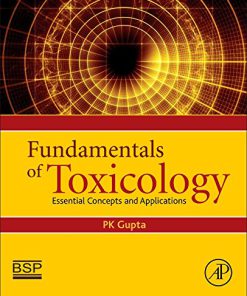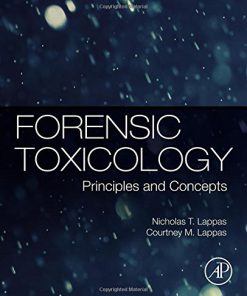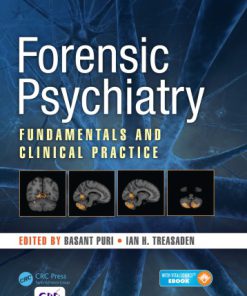Fundamentals of analytical toxicology clinical and forensic 2nd Edition by Robert Flanagan, Eva Cuypers, Hans Maurer, Robin Whelpton 1119122371 9781119122371
$50.00 Original price was: $50.00.$25.00Current price is: $25.00.
Fundamentals of analytical toxicology clinical and forensic 2nd Edition by Robert J. Flanagan, Eva Cuypers, Hans H. Maurer, Robin Whelpton – Ebook PDF Instant Download/DeliveryISBN: 1119122371, 9781119122371
Full download Fundamentals of analytical toxicology clinical and forensic 2nd Edition after payment.
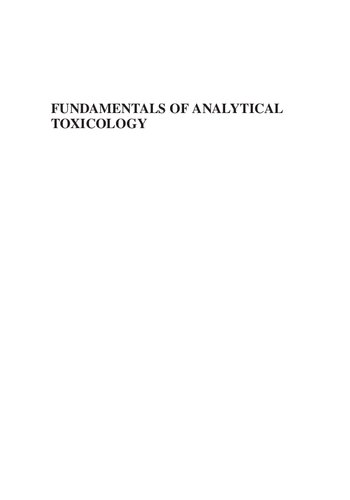
Product details:
ISBN-10 : 1119122371
ISBN-13 : 9781119122371
Author: Robert J. Flanagan, Eva Cuypers, Hans H. Maurer, Robin Whelpton
Fundamentals of Analytical Toxicology is an integrated introduction to the analysis of drugs, poisons, and other foreign compounds in biological and related specimens. Assuming only basic knowledge of analytical chemistry, this invaluable guide helps trainee analytical toxicologists understand the principles and practical skills involved in detecting, identifying, and measuring a broad range of compounds in various biological samples. Clear, easy-to-read chapters provide detailed information on topics including sample collection and preparation, spectrophotometric and luminescence techniques, liquid and gas-liquid chromatography, and mass spectrometry including hyphenated techniques.
Fundamentals of analytical toxicology clinical and forensic 2nd table of contents:
Section A: The Basics
1 Analytical Toxicology: Overview
1.1 Introduction
1.2 Modern analytical toxicology
1.3 Provision of analytical toxicology services
1.4 Applications of analytical toxicology
1.5 Summary
References
2 Sample Collection, Transport, and Storage
2.1 Introduction
2.2 Clinical samples and sampling
2.3 Guidelines for sample collection for analytical toxicology
2.4 Sample transport, storage, and disposal
2.5 Common interferences
2.6 Summary
References
3 Basic Laboratory Operations
3.1 Introduction
3.2 Aspects of quantitative analysis
3.3 Use of internal standards
3.4 Method comparison
3.5 Non-parametric statistics
3.6 Quality control and quality assessment
3.7 Operational considerations
3.8 Summary
References
4 Aspects of Sample Preparation
4.1 Introduction
4.2 Modes of sample preparation
4.3 Plasma protein binding
4.4 Hydrolysis of conjugated metabolites
4.5 Extraction of drugs from tissues
4.6 Summary
References
5 Colour Tests, and Spectrophotometric and Luminescence Techniques
5.1 Introduction
5.2 Colour tests in toxicology
5.3 Colour tests for pharmaceuticals and illicit drugs
5.4 UV/Visible spectrophotometry
5.5 Fluorescence and phosphorescence
5.6 Chemiluminescence
5.7 Infrared and Raman spectroscopy
5.8 Summary
References
6 Immunoassays and Related Assays
6.1 Introduction
6.2 Basic principles of competitive binding assays
6.3 Heterogeneous immunoassays
6.4 Homogenous immunoassays
6.5 Microparticulate and turbidimetric immunoassays
6.6 Assay calibration, quality control, and quality assessment
6.7 Interferences and assay failures
6.8 Aptamer-based assays
6.9 Enzyme-based assays
6.10 Summary
References
Section B: Separation Science
7 Separation Science: Theoretical Aspects
7.1 General introduction
7.2 Theoretical aspects of chromatography
7.3 Measurement of analyte retention
7.4 Summary
References
8 Planar Chromatography
8.1 Introduction
8.2 Qualitative thin-layer chromatography
8.3 Quantitative thin-layer chromatography
8.4 Summary
References
9 Gas Chromatography
9.1 Introduction
9.2 Instrumentation
9.3 Columns and column packings
9.4 Headspace and ‘purge and trap’ analysis
9.5 Formation of artefacts in gas chromatography
9.6 Derivatization for gas chromatography
9.7 Chiral separations
9.8 Summary
References
10 Liquid Chromatography
10.1 Introduction
10.2 General considerations
10.3 Detection in liquid chromatography
10.4 Columns and column packings
10.5 Modes of liquid chromatography
10.6 Chiral separations
10.7 Derivatives for liquid chromatography
10.8 Use of liquid chromatography in analytical toxicology
10.9 Summary
References
11 Supercritical Fluid Chromatography
11.1 Introduction
11.2 General considerations
11.3 Detection in supercritical fluid chromatography
11.4 Columns and column packings
11.5 Chiral separations
11.6 Toxicological and forensic applications
11.7 Summary
References
12 Capillary Electrophoretic Techniques
12.1 Introduction
12.2 Theoretical aspects
12.3 Sample injection in capillary electrophoresis
12.4 Detection in capillary electrophoresis
12.5 Other capillary electrokinetic modes
12.6 Capillary electrophoretic techniques in analytical toxicology
12.7 Summary
References
13 Mass Spectrometry
13.1 Introduction
13.2 Instrumentation
13.3 Gas chromatography-mass spectrometry
13.4 Liquid chromatography-mass spectrometry
13.5 Supercritical fluid chromatography-mass spectrometry
13.6 Capillary electrophoresis-mass spectrometry
13.7 Direct introduction mass spectrometry
13.8 Presentation of mass spectral data
13.9 Interpretation of mass spectra
13.10 Quantitative mass spectrometry
13.11 Mass spectrometry imaging
13.12 Summary
References
14 Ion Mobility Spectrometry
14.1 Introduction
14.2 Theoretical aspects
14.3 Types of ion mobility spectrometry
14.4 Resolving power
14.5 Interfacing ion mobility spectrometry
14.6 Applications of ion mobility spectrometry in analytical toxicology
14.7 Summary
References
Section C: Essential Pharmacokinetics
15 Absorption, Distribution, Metabolism, and Excretion of Xenobiotics
15.1 Introduction
15.2 Movement of drugs and other xenobiotics around the body
15.3 Routes of administration
15.4 Distribution
15.5 Metabolism
15.6 Excretion
15.7 Pharmacogenetics and pharmacogenomics
15.8 Summary
References
16 Pharmacokinetics
16.1 Introduction
16.2 Fundamental concepts
16.3 Absorption and elimination
16.4 Drug accumulation
16.5 Sustained-release preparations
16.6 Non-linear pharmacokinetics
16.7 Multi-compartment models
16.8 Non-compartmental methods
16.9 Factors affecting pharmacokinetic parameters
16.10 Disease
16.11 Pharmacokinetics and the interpretation of results
16.12 Summary
References
Section D: Analytical Toxicology
17 Toxicology Testing at the Point of Contact
17.1 Introduction
17.2 Use of point of contact testing
17.3 Toxicology testing at the point of contact
17.4 Interferences and adulterants
17.5 Quality assessment
17.6 Summary
References
18 Laboratory Testing for Substance Misuse
18.1 Introduction
18.2 Urine testing
18.3 Oral fluid testing
18.4 Blood testing
18.5 Hair testing
18.6 Breath testing
18.7 Sweat testing
18.8 Summary
References
19 General Analytical Toxicology
19.1 Introduction
19.2 Gas chromatography
19.3 Gas chromatography-mass spectrometry
19.4 Liquid chromatography
19.5 Liquid chromatography-mass spectrometry
19.6 Liquid chromatography-high resolution mass spectrometry
19.7 Summary
References
20 Therapeutic Drug Monitoring
20.1 Introduction
20.2 Sample collection
20.3 Sample types
20.4 Analytical methods
20.5 Factors affecting interpretation of results
20.6 Gazetteer
20.7 Summary
References
21 Trace Elements and Toxic Metals
21.1 Introduction
21.2 Sample collection and storage
21.3 Sample preparation
21.4 Atomic spectrometry
21.5 Colorimetry and fluorimetry
21.6 Electrochemical methods
21.7 Catalytic methods
21.8 Neutron activation analysis
21.9 Chromatographic methods
21.10 Quality assessment
21.11 Summary
References
22 Clinical Interpretation of Analytical Results
22.1 Introduction
22.2 Clinical toxicology
22.3 Forensic toxicology
22.4 Gazetteer
22.5 Sources of further information
22.6 Summary
People also search for Fundamentals of analytical toxicology clinical and forensic 2nd:
analytical techniques in forensic toxicology
types of forensic toxicology
what is analytical toxicology
clinical vs forensic toxicology
fundamentals of analytical chemistry 10th edition
Tags: Fundamentals, analytical toxicology, forensic, Robert Flanagan, Eva Cuypers, Hans Maurer, Robin Whelpton
You may also like…
Housekeeping & Leisure - Papercrafts
Origami Design Secrets 2nd Edition by Robert Lang 1040059968 9781040059968
Physics - Mechanics
Biomechanics A Case Based Approach Second Edition by Sean P Flanagan 1284102343 9781284102345
Medicine
Fundamentals of Analytical Toxicology: Clinical and Forensic 2nd Edition Robert J. Flanagan
Politics & Philosophy - Social Sciences


